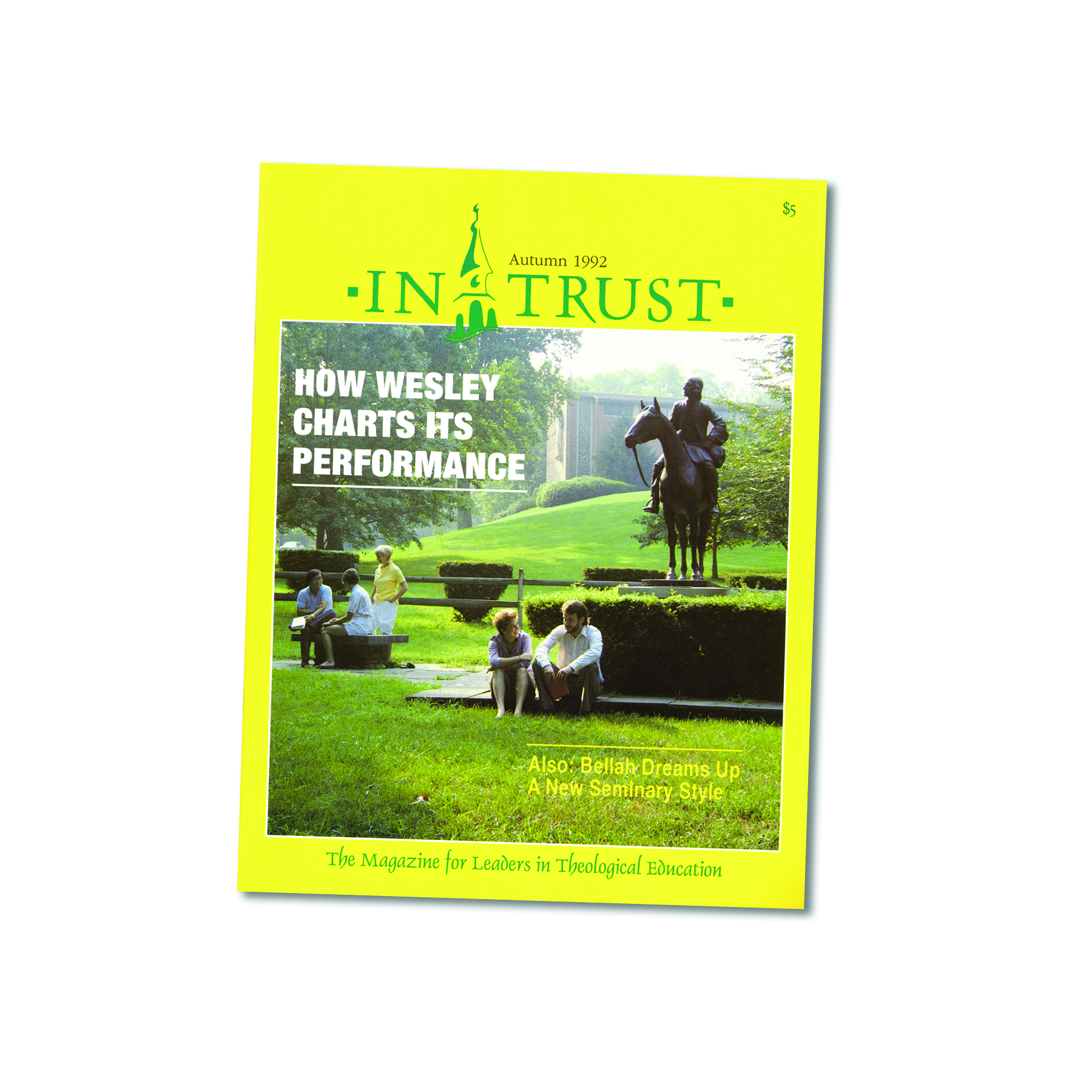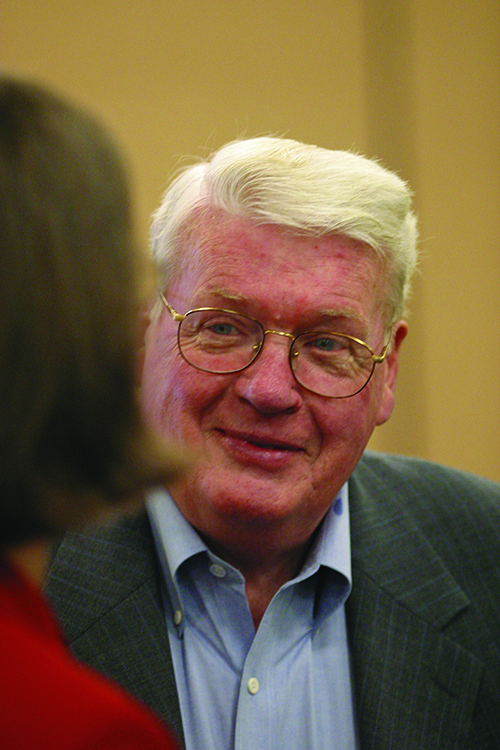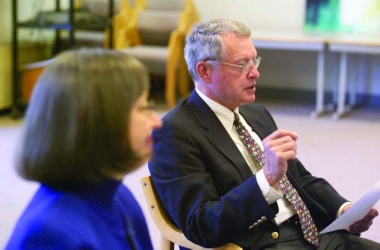 |
| The Autumn 1992 issue was the first "new and improved" issue of In Trust. "The cover story was exactly what I thought an In Trust article ought to be," says editor emeritus William MacKaye. |
The biggest religion news stories of 1988, according to a survey of religion reporters, were the defrocking of Jimmy Swaggart following a sex scandal, the national protests surrounding the release of Martin Scorsese's Last Temptation of Christ, and the naming of Barbara Harris as the first Anglican woman bishop. The list, which was compiled at the end of that year, also included Pat Robertson's and Jesse Jackson's presidential campaigns, George H.W. Bush's election victory garnered with the support of religious conservatives, and the National Council of Churches" financial crisis and call for reorganization.
Far from the headlines and camera crews, another story was just beginning to unfold: the story of In Trust.
While lacking the drama that filled the headlines, In Trust's history captures with clarity and prescience the changes that have occurred in North American theological education over the last few decades. And In Trust's 20th anniversary offers a chance to reflect on some of the issues, developments, and personalities behind the organization and its direction.
The care and feeding of trustees
The seeds of In Trust date back to September 1987, when Robert W. Lynn, who was then the senior vice president for religion at Lilly Endowment Inc., met with J. L. Zwingle, retired executive director of the Association of Governing Boards of Universities and Colleges (AGB), and Christa R. Klein, Lilly's consultant on seminary trusteeship. The three discussed developing an "occasional periodical" for seminary trustees that would include essays, book excerpts, and other material covering issues like trusteeship, governance, theological education, and the religious landscape.
"Boards of theological schools were changing to meet the challenge of reduced funding from denominations and increased institutional complexity. They were adding more members who weren't clergy or alumni," says Klein, who is now president and executive director of In Trust. "More were coming from the corporate world and the professions. Often they didn't know theological education, and were struggling in isolation to make sense of their new responsibilities." Klein and the others felt that the time had come to make sure that the concerns of these new trustees were being addressed--not just those of the older board members, many of whom were clergy. They sought to place a new, positive emphasis on the role of trusteeship in theological education.
Lynn was deeply influenced by the writings of Robert Greenleaf, a retired business executive and Quaker who had done extensive writing on trustees as "servant leaders" in nonprofit organizations. Lynn wanted to attend to, as he called it, "the care and feeding of [seminary] trustees," and he recruited Zwingle, who had done that for college and university boards, to help.
For his part, Zwingle was interested in strengthening trusteeship at seminaries because he was troubled by the way the church was being marginalized in American society. A lifelong Presbyterian, Zwingle wrote in a 1989 memorandum that "nothing could be more urgent than the restoration of theological studies and the development of lay concern and support.
Occasional papers
By the late 1980s, theological schools had already been undergoing significant shifts, including a decline in denominational funding and an increase in the number of nontraditional and second-career students. Even those seminary boards that were not themselves undergoing dramatic changes were being forced to address new issues and challenges.
A collection of essays sent to seminary presidents in May 1988 with a letter from Lynn laid the foundation for what would become In Trust magazine. Lynn wrote that the Lilly Endowment would be underwriting "a set of occasional papers designed to inform leaders in the churches, especially those lay people who do not have ready access to much of the relevant research about American religion and the governance of religious institutions." A representative advisory group guided the endeavor.
 |
"It's a wonderful array of thoughtful, devout people with a scholarly approach to Christianity," says Father Vincent Cushing, first chair of In Trust's board. He cites In Trust's ecumenical nature as especially significant.
(Greg Schneider) |
That advisory group met several times in 1988, and its gathering in October at Washington Theological Union included Zwingle, Klein, Franciscan Father Vincent Cushing, who was president of WTU, and Garth Rozell, the academic dean at Gordon-Conwell Theological Seminary. They were joined by former Washington Post magazine editor and religion editor William MacKaye, who had agreed to serve as editor.
At that meeting, after much deliberation, the occasional paper series was christened In Trust. The group--which grew to become the new editorial council, with Cushing as chair--also brainstormed themes that were facing theological schools and their boards, including globalization, ecumenism, continuing education, enrollment management, spiritual formation, tenure, shifts in the seminary presidency, the quality of seminarians, and financial matters. They planned that some of those topics would be covered in original articles, while other material would be reprinted from periodicals and books like Greenleaf's Servant Leadership: A Journey into the Nature of Legitimate Power and Greatness (Paulist Press, 1977).
The publication addressed a group of theological schools marked by both significant differences and common concerns. "Trusteeship in itself was such a varied picture within theological schools," says Cushing. While some theological schools had boards that operated in a savvy, policy-making manner, at other schools, both Protestant and Catholic, "trusteeship was about coming to meetings and rubber-stamping the budget and not ever asking questions." In some instances, boards were failing to address academic quality, finances, administration, and other aspects of institutional life. "We saw the need to offer ongoing education and information on these," says Cushing.
Also, with term limits and new members regularly being added to boards, there was an ever-present need for the variety of material published in In Trust, from "board membership 101" to more nuanced and thoughtful pieces on trends in theological education.
The publication brought a fresh perspective to the field. "As In Trust cultivated a resource to inform boards, it was informing everyone, in a way," says Daniel O. Aleshire, executive director of the Association of Theological Schools. "Even though the magazine's focus was governance, it comprehensively addressed the character and work of these schools. Prior to that time there were publications from individual schools and newsletters from organizations like the Fund for Theological Education and ATS, but In Trust offered journalistic attention to the wider world of theological education."
As MacKaye took the reins as editor of In Trust, his experience at the Washington Post convinced him that the best way to teach was through stories: "Educating board members could and should be done by telling stories about how the work was being done," he says. The best kinds of stories, he believed, the ones from which the most valuable insights could be gleaned, were "real ones, with names attached, telling things that really happened."
Especially in the early years, persuading schools to share their sometimes hard-earned wisdom with their colleagues in the field could be difficult. And, on a few occasions, "we stepped in too quickly, while internal tensions ran high and before the full implications of an event were clear," says Klein. But those experiences helped to shape the current approach, which asks board chairs and presidents to share their reflections after having come to terms with what they've learned from an event or crisis.
In Trust's mailing list -- and name recognition -- grew slowly, primarily by presidents signing up those board members they thought should receive a copy. But three years into the endeavor, only 40 schools had opted to subscribe, and circulation hovered at 250. (Circulation today is 7,720.) "It hadn't proved itself," says Klein, "And schools were not necessarily used to reading about each other."
Expanding focus
A major turning point came in 1992, when another grant from the Lilly Endowment moved In Trust to a quarterly publishing schedule, added a four-color cover, and expanded its mailing list to include every trustee at every accredited theological school in the United States and Canada, sending them the magazine at no cost. "We were working too hard not to broadcast what we were learning from the schools more widely," says Klein.
The Autumn 1992 issue was the first "new and improved" issue, and MacKaye recalls it fondly: "The cover story was exactly what I thought an In Trust article ought to be." G. Douglass Lewis, then president of Wesley Theological Seminary in Washington, agreed to share the school's financial reports with the magazine, and in "How Wesley Counts," financial experts scrutinized each line, offering comments and critiques. "People learned a lot from that story," says MacKaye. "It demonstrated to the theological community that In Trust was not out to embarrass anybody but really aimed to help theological schools learn from each other's experiences."
The magazine continued to define trustee basics, but unquestionably the meat of the publication was in its coverage of trends and topics in theological education and institutional governance. In Trust may have been founded to attend to the care and feeding of trustees, but by the mid-1990s its focus had expanded to educate boards about the larger ecosystems of theological education and their role in ensuring an institution's health, growth, and sustainability.
In the context of developing and defining 'effective trusteeship," it became evident the real work for In Trust focused around governance," says Robert E. Cooley, president emeritus of Gordon-Conwell Theological Seminary and the second chair of In Trust's own board of directors. While trusteeship focuses on the role of an individual on a governing board, "Governance, as it emerged in our thinking, focuses on the collective work of the board in relation to the president and faculty, and is particularly related to the systems of decision making within the institution."
 |
|
As the second chair of In Trust's board, Robert Cooley became the organization's leading thinker on board governance. He has promoted the systematization of the board's work and is a highly sought mentor by presidents and board chairs at theological schools across North America.
(Photo by Matthew Lester)
|
The transition from trusteeship to governance created some marvelous learning experiences for those of us in the middle of that conversation," says Cooley, who became involved in In Trust more than a dozen years ago. "It demanded our best creativity and intellectual understanding of the decisionmaking process."
A recognized partner
A key development came with In Trust's incorporation as a nonprofit organization in 1995. This move prepared the way for In Trust Inc. to become the publisher of its quarterly magazine and a provider of other educational services. In Trust's editorial council became its board of directors with responsibility for its mission and economic well-being.
In Trust's first venture beyond the magazine was its Good Faith Governance Seminars, introduced in 1997 and attracting 130 teams of presidents and board leaders from 100 schools over the next 10 years. Its Governance Mentor service grew out of the seminars, where each school team had been assigned a facilitator to work with it in private sessions during the two-day event. Half a dozen other assessment resources, including the Institutional Health Checklist, Financial Health Checkup, the Board Performance Audit, and Presidential Evaluation, were added to the In Trust toolkit over time.
"There continues to be a growing awareness of the centrality of governance in theological education," says In Trust's current board chair, G. Douglass Lewis (whose initial involvement with In Trust was when he opened Wesley's books for the 1992 cover story). "What we discovered over the years is that schools want onsite support rather than going off to a conference for help." The Governance Mentor service was rolled out in 2005, and already mentors have visited 60 schools to work with boards and presidents.
"Our distinction is to define 'best practices" most suitable for theological schools and then to customize them for the unique tradition and history of each school," says Klein. "We want to challenge schools to the highest standards of performance. The stakes are so high for theological schools that we believe board members want to be called to do their best. To do that, they need the most pertinent assessment information about themselves, their presidents, and their institution's performance."
Many foundations have seen the significance and specialized nature of In Trust's work and generously provided financial support. In addition to the Lilly Endowment's support, the Arthur Vining Davis Foundations, the E. Rhodes and Leona B. Carpenter Foundation, the Henry Luce Foundation, and the Kern Family Foundation, among others, have contributed substantially to In Trust's projects and operations.
Over the years, seminaries themselves have come to recognize In Trust as a valuable partner in their work. Today, 190 institutions in the United States and Canada are paying members of In Trust and benefit from member rates on In Trust's services.
"To me it's an inspiring story of how a good idea can, over time, be persuasive," says Malcolm Warford, one of the early members of the editorial council and now director of the Lexington Seminar, a project that helps seminaries improve teaching and learning.
Those familiar with the landscape of theological education believe In Trust continues to fill a crucial role. "It's my judgment that In Trust is needed now more than ever," says Cooley, who points to a board's need for "an astute understanding of the governance process, a full understanding of precise data, and a full understanding of the purpose and mission of the institution" to do its job effectively.
The issues facing seminaries and their boards--including all those topics brainstormed at the 1988 editorial council meeting at the Washington Theological Union--have grown more intense over the past two decades. Most noticeable are the stark economic realities of the vast majority of schools. "It used to be you could make basic institutional decisions about living modestly," says Warford. "One of the difficulties now is mandated costs that are outside of your control. Keeping computer systems functioning and up-to-date is an enormous expense. All the requirements of accreditation--evaluation, accounting, and assessment--carry a not-insubstantial price tag. And the kind of staffing needs for admissions and development simply weren't there decades ago."
 |
|
In Trust's current board chair, G. Douglass Lewis, remained on the leading edge of current thinking as he edited A Handbook for Seminary Presidents, a comprehensive guide to theological school leadership published in 2006. Lewis was president of Wesley Theological Seminary for 20 years before his retirement in 2002. Here he is seated adjacent to In Trust's president, Christa Klein.
(Photo by Matthew Lester)
|
There's a reason boards are willing to tackle those challenges: A survey of In Trust readers found that 84 percent of seminary board members see their service as an extension of their own Christian commitment. And that greater good is a real motivator to slog through niggling and unwieldy challenges alike.
"The fundamental question that trustees need to be grappling with is the basic identity of the school," says Warford. "Trustees need the courage to read the signs of the times to lead the school to re-identify its basic mission and structure."
The story of In Trust may still be far from the headlines this year, but helping equip theological schools for effective governance is a significant step toward achieving and sustaining their mission to provide church leaders and tend Christian traditions.
Building a "wide community of colleagues"
 From the beginning, ecumenism was the name of the game. "One thing I learned in my years as religion writer for the Washington Post was that the divide among churches, particularly between Roman Catholic and non-Roman Catholic bodies, is not nearly as wide as a lot of people think it is," says William MacKaye, who served as In Trust's editor from 1988 to 2004. "I wanted to do what I could to help people on both sides of the divide to recognize their similarities. My hope was that some kind of community could emerge in the world of theological education."
From the beginning, ecumenism was the name of the game. "One thing I learned in my years as religion writer for the Washington Post was that the divide among churches, particularly between Roman Catholic and non-Roman Catholic bodies, is not nearly as wide as a lot of people think it is," says William MacKaye, who served as In Trust's editor from 1988 to 2004. "I wanted to do what I could to help people on both sides of the divide to recognize their similarities. My hope was that some kind of community could emerge in the world of theological education."
Franciscan Father Vincent Cushing, then president of the Washington Theological Union, distinctive for its cooperative governance by nine Roman Catholic religious orders, offered his school to manage the project grant to found In Trust. MacKaye was happy with that development and says his initial thought was, "I live in Washington and I'm not a Roman Catholic, so it should be at a Roman Catholic school."
"We needed to prove we had no one denominational bias," says Christa Klein, In Trust's president. "From the start, we sought out writers and advisors with strong ties to their own traditions but who were concerned about the health of Christianity and theological education in North America. We had to recognize the many and various ways that schools were organized and governed to pursue their missions."
Even schools with significant theological differences face similar governance issues, including financial stress, student recruitment, and faculty development. But In Trust has helped board members at schools from the same tradition understand a bigger picture and forge new connections, too. "For the most part, trustees at one institution had no knowledge of the situation at other schools," says Malcolm Warford, an early editorial council member. "It was helpful to recognize the reality of a wider community of colleagues that share a common set of responsibilities."
"The remarkable thing about In Trust for me has been its ecumenical character," says Robert Cooley, who joined the organization's board of directors after In Trust's incorporation and while president of Gordon-Conwell Theological Seminary. "The persons involved over these many years have come from many denominations and movements and become a community that allows for these ecumenical relationships to flourish. It adds a richness we could not have realized otherwise."
Cushing agrees. "It's a wonderful array of thoughtful, devout people with a scholarly approach to Christianity. My ecumenical association was by far the most enriching experience for me."